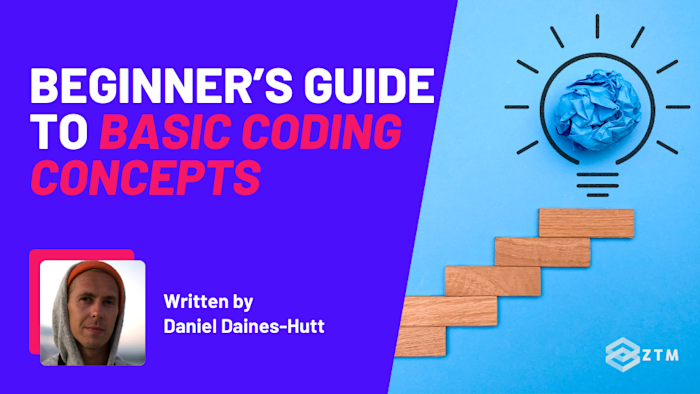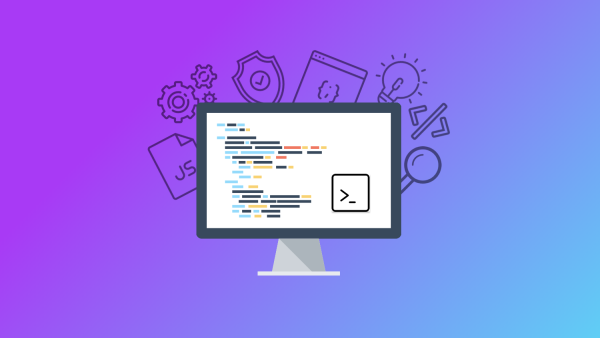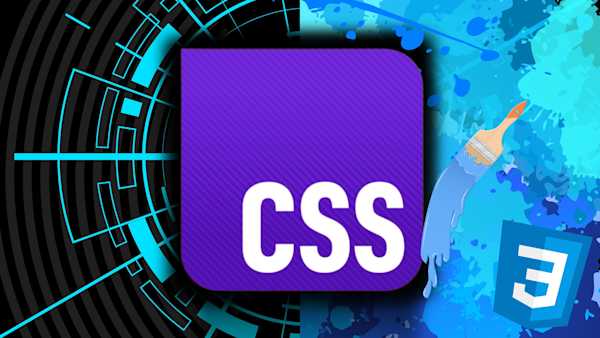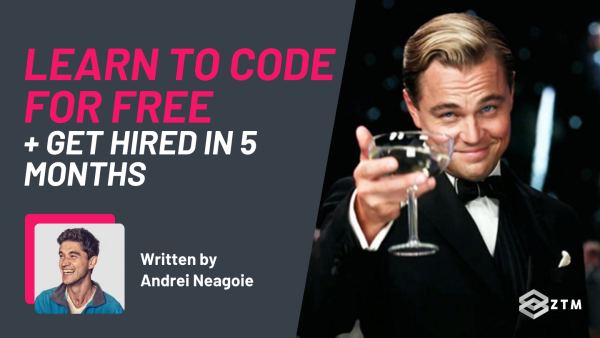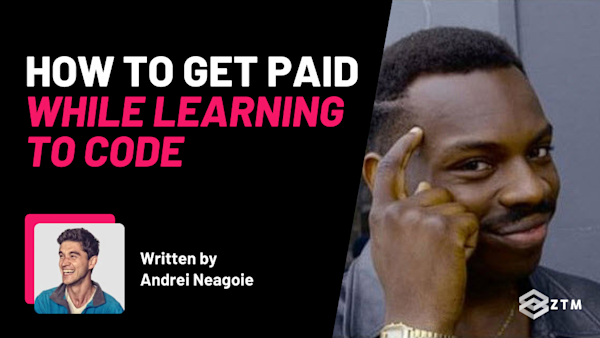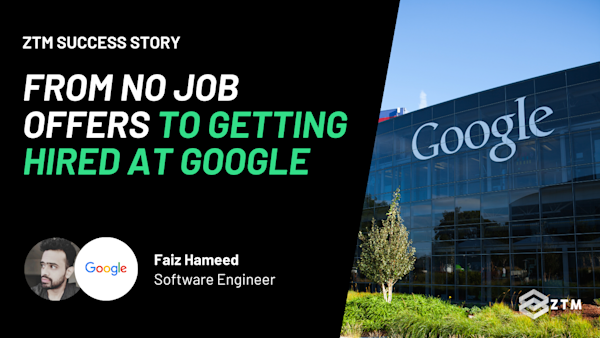Underneath all the syntax and tools, every programming language is built on the same set of core ideas:
How to store and use information
How to make decisions
How to repeat things, and
How to break problems into smaller chunks
These form the core concepts behind every app, website, and piece of software you’ve ever used, and they’re one of the first things worth learning when you're starting out.
So in this guide, I’ll walk you through the four basic building blocks that every programmer relies on. You’ll see what they do and how they work, with super simple examples to make it all click.
Let’s get into it.
Concept #1. Variables
Apps don’t just run once and forget everything. They need to remember who you are, what you clicked, what settings you chose, or what the result of a calculation was. If they couldn’t store and reuse that information, the program would be stuck starting over every time which would be incredibly time consuming and inefficient.
We call this information a variable.
The easiest way to think of them is like a box or container where you can store things. However, because you can store anything you want in the box, those items can vary. (Hence the name).
We can also have multiple different types of boxes for this data.
For example
Let’s say you’re creating an Amazon Prime account. You enter your name, address, and card details when you sign up. Later, when you go to check out, you don’t need to retype that info because Amazon already has it. It saved those details in variables like name , address , and cardInfo , so the system can quickly plug them back in when needed.
Instead of hardcoding your personal data or asking for it every time, the program stores it once and reuses it whenever necessary.
Why does this matter for you as a developer?
Because once you understand variables, you unlock the ability to:
Keep track of anything a user does (inputs, progress, results)
Build programs that adapt to different users or conditions
Reuse and organize your code instead of repeating yourself
Nearly everything in programming builds on this. Variables let you build dynamic, interactive apps instead of static one-offs. That’s true whether you’re making a calculator, a form, a quiz, or a multiplayer game.
Concept #2. Logic and conditionals
Once your app has stored some information using variables, the next thing it needs to do is make decisions based on that information, and that’s where logic comes in.
Logic allows us to add in ‘what if’ rules into our code to help deal with different situations or scenarios that might occur.
For example
Let’s say Amazon has your card info saved in a variable and you want to make a purchase. Perhaps you found a DVD you want, and click 'buy now'.
At this point Amazon needs to run a few different logical checks, starting with:
Is your card valid? If yes, it should continue
Is the card is expired? If yes, it should cancel the purchase
This kind of branching ‘if this is true, do that; otherwise, do something else’ is at the heart of programming.
You might not notice it as a user, but logic is everywhere in software. It’s how an app knows when to show you a login screen, when to display an error, when to personalize your homepage, and when to flag something as suspicious.
Every time the software reacts differently based on what’s happening, it’s using logic and conditionals behind the scenes. These are statements that help the code decide which path to take.
There are three main types:
if: Check if something is true, and do something if it is
else if: Check a second (or third) condition if the first one wasn’t true
else: Handle anything that didn’t match the earlier conditions
You can also combine conditions using logical operators:
and means both conditions must be true
or means either condition can be true
not flips a condition so that true becomes false, and vice versa
For example
If we go back to the Amazon prime example from before, and we’re trying to buy our new DVD boxset.
We said that the first check would be to see if the purchase could go through, and that's true. However, it would then cascade through other logic and conditional operators to check multiple things at once:
If your card is valid AND the item is in stock, complete the order
If the address is international OR the item is oversized, add a shipping fee
If user confirms, being to process delivery
These logical operators give your app more flexibility because instead of checking just one thing at a time, it can also respond to more complex scenarios.
Handy right?
So at this point we’ve got stored information (variables), and we’ve got a way to act on that information (logic). But decisions are only part of what apps need to do. In most real programs, you also want to repeat things. Not just once or twice, but over and over on automation.
To handle those kinds of repetitive tasks, we need loops.
Concept #3. Loops
Loops let you repeat tasks multiple times, without having to rewrite the code for that task.
For example
Let’s go back to Amazon Prime again. Only this time, you’ve got your DVD boxset of Star Trek Season 1 in your cart, and now you see a deal where if you buy any four more seasons, you get a discount.
So you treat yourself and add a bunch more to your cart.
Now, for each of those DVDs, Amazon needs to check everything we’ve talked about so far:
Whether it’s in stock
How much tax to apply
And what the shipping estimate will be
But instead of writing separate code for each item, Amazon’s system can just loop through your list and run the same logic for each one, without repeating the code itself:
Check inventory
Calculate tax
Estimate shipping
Repeat for next item in cart until list is empty
And the wild thing is, it scales effortlessly because you could run that loop a thousand times with one small piece of code. Not only does this save time but it massively reduces the chances of making a mistake.
Better still?
This idea of packaging work and reusing it doesn’t stop with loops either!
Concept #4. Functions
A function is like a mini-program inside your program that you can reuse.
So here's the thing: Once you start writing your code, you’ll quickly notice that certain tasks keep popping up again and again. Maybe it’s checking if a product qualifies for free shipping, calculating tax, or formatting a price. Writing out that logic every single time not only clutters your code, it also makes it harder to manage and fix later.
Functions are how you clean that up.
They let you take a specific task, give it a name, and define exactly what it should do. Then, whenever you need that task done, you just call the function and that one line will now run the whole block of logic.
For example
If we go back to Amazon Prime again. Let’s say the system needs to check whether each item in your cart qualifies for free shipping.
However, instead of rewriting that check for every item, you’d write a function called isEligibleForFreeShipping(item). It does everything that you wrote in your code before, but now you don’t need to rewrite the whole thing every time.
What you’re doing is breaking your program into smaller, reusable parts. Each part handles a specific job, and your main code just focuses on when and how to use them. That’s how professional developers keep things organized and flexible, even in massive projects.
Functions (just like loops) also make your code easier to fix and scale. Because if the free shipping rule changes, you update the logic once in the function. This would then update it everywhere that it's being used.
Talk about a time saver!
Everything builds from here!
Hopefully you can see now that these are more than just concepts, but mental models for coding and thinking like a programmer.
I know they’re fairly basic and we only scratched the surface, but the reality is once you understand variables, conditionals, loops, and functions, you’ve already learned the four core ideas that power every modern app, website, and piece of software.
And the rest? It builds on top of this.
Arrays are just collections of variables. Objects are variables that hold other variables. Event listeners run functions when something happens. APIs send and receive data that you store in variables, loop through, or filter with conditionals.
If it sounds complex now, don’t worry. You already have the core pieces. Everything else is just new ways of combining them.
The trick now is to start putting this into action and learn a programming language.
You can check out this guide here to learn how to code for free
Or check out this guide here for the best programming languages to learn first as a beginner
Or you can check out this course here to learn Web Development. (Spoiler alert but it’s one of the easiest ways to learn to code and get started in tech)
